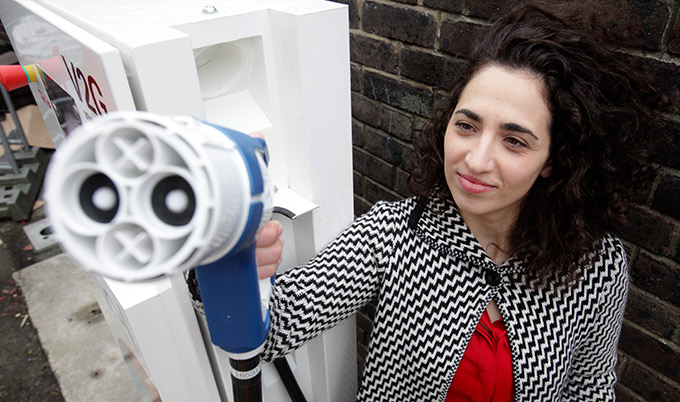V2G
Driving the grid
Published on: 18 January 2017
One of UK’s first ‘vehicle-to-grid’ chargers installed at Newcastle University.
The first ten vehicle-to-grid charging points which allow energy to travel both to and from the car’s battery have been installed at Nissan’s Cranfield Research Facility and Newcastle University.
The innovative technology - developed in collaboration between Enel and Nissan - will turn Electric Vehicles (EVs) into mobile energy storage systems and is the next step towards allowing EVs to become fully integrated with the electricity grid.
Providing energy and power services to the grid when the car is parked, the chargers can also ensure that the battery is fully charged when the driver needs it. Nissan believes that, if fully integrated, the concept could save £2.4bn in electricity costs by 2030.
Linked to the Smart Grid Laboratory at the University’s £20m National Centre for Energy Systems Integration (CESI), the new V2G charging point will be used to help researchers and industry understand what role EVs will play in future energy supply and demand.

Gobal partners
Newcastle University’s Myriam Neaimeh is a researcher in Transport and Energy and leading the vehicle-to-grid project.
“Smart energy storage has the potential to be a real game changer as we move towards decarbonising the grid and EVs will play a key role in this,” she explains.
“Using the new charging system, cars will not just take energy from the grid but can also be used to put energy back, providing a number of grid services that can support the operation of the power system and lower the cost of EV ownership.”
The announcement coincides with a visit from Employment Minister Damian Hinds who is in the North East to mark the release of the latest labour market figures.
While touring the University’s School of Electrical and Electronic Engineering, the Minister will meet the teams working with global companies such as Nissan, Siemens and Jaguar Land Rover. This latest project builds on the University’s world-leading research in energy and future transport.
Employment Minister Damian Hinds said:
“Newcastle University’s work is a strong example of the UK’s world-class leadership in global science and research.
“Innovation is central to economic growth, which is why we’ve committed an extra £2bn a year by 2020 on research and development to keep us ahead of the game and support the jobs of the future.”
Reducing future emissions
At the moment the number of EVs is too low to have a significant impact and it is estimated there will need to be more than two million electric vehicles on the UK’s roads if we are to meet our commitment to reduce carbon emissions then by 2030.
Assuming half of these are plugged into the grid using a 10kW V2G charger between 9am-4pm, and each EV battery can store 50kWh then this offers a potential energy storage resource of 50GWh and around 10GW of power capacity– significantly bigger than any energy storage system currently installed or planned.
“Clearly drivers aren’t going to want to clock out of work and find they can’t get home because their car battery has been drained,” Ms Neaimeh says. “So the system can be programmed and controlled through an aggregator platform, developed by NUVVE, to ensure the battery is fully charged at, say, five o’clock.
“With an extensive charging infrastructure at work and at home, the whole process can start again anytime the vehicle is plugged into the grid for a long period of time.”
Real World Trials
A reliable, affordable and dependable flow of electricity is vital to power society in the 21st century.
But energy flow is now a two-way process. Low carbon technologies generated by solar panels, wind farms and in the future EVs, are feeding into national power networks and bringing new challenges to be overcome.
The Newcastle charger will be linked to the University’s Smart Grid Laboratory, a £2 million facility funded jointly by Siemens Energy Automation Division and Newcastle University.
Together with a £2 million grid scale energy storage demonstrator, experts at Newcastle University are leading the UK's largest Smart Grid project to look at how sources of power can be managed at a reasonable cost, paving the way for new energy storage systems in the future.
The entire project will be based at Science Central, a £300m regeneration project in the heart of Newcastle and a test-bed for sustainable, urban development. Science Central is a partnership between Newcastle University and Newcastle City Council and is predicted to create an extra 4,000 jobs and 2,000 sustainable family homes, using some of the new technologies that are being trialled on the site.
In addition to participating in real-world trials, the Smart Grid Lab will allow the research team to go offline with the charger once in a while and try out innovative ideas without risking the network.
Professor Phil Taylor, Siemens Professor of Energy Systems and Director of the EPSRC National Centre for Energy Systems Integration (CESI) at Newcastle University, explained:
“Science Central is a unique, full-scale test-bed which allows us to test novel technologies and interventions in the real world.
“Importantly we are responding to what people want and need. Public demand for cleaner, cheaper energy is driving our research into energy storage and smart energy. We know more people would drive an EV if it were cheaper so the vehicle to grid research is looking at how we can reduce long term costs by providing energy and balancing services to the grid.”
The trial is part of a wider Nissan project to develop 100 V2G storage units in the UK.
Nissan believes that the announcement marks an “important step” in an overall plan to highlight how zero-emission vehicles – including the 100% electric Nissan Leaf and the e-NV200 – can be connected with the grid to boost efficiencies.



